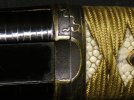Gorgeous as always Ben.
And just because I'm a bit OCD, I found this at Wikipedia:
Aikuchi
The aikuchi (匕首?) (literally "fitting mouth") is a form of mounting for small Japanese swords in which the handle and the scabbard meet without a guard (tsuba) in between.[6] Originally used on the koshigatana (a precursor to the wakizashi) to facilitate close wearing with armor,[7][8] it became a fashionable upper-class mounting style for tantō (daggers) from the Kamakura period onwards.
According to S. Alexander Takeuchi from University of North Alabama, Department of Sociology, aikuchi, is a form of koshirae (mounting style) which commonly was used in tantō creation. The nomenclature of the word "aikuchi" is the following: the Japanese: ai is a gerund which means meeting and Japanese: kuchi is a noun that means mouth. The same formula is used in koi-guchi. So, aikuchi initially was a style of mounting in which the fuchi meets with the koi-guchi.
Kaiken
The aikuchi tantō known as kaiken is a small 8-10 inch long, single or double bladed dagger[10] without ornamental fittings housed in a plain mount, formerly carried by men and women of the samurai class in Japan. It was useful for self-defense indoors where the long katana and intermediate wakizashi were inconvenient. Women carried them in their kimono either in a pocket like fold (futukoro) or in the sleeve (tamoto).[11] for self-defense or for suicide by means of slashing the veins in the left side of the neck (carotid artery).[12][13]








